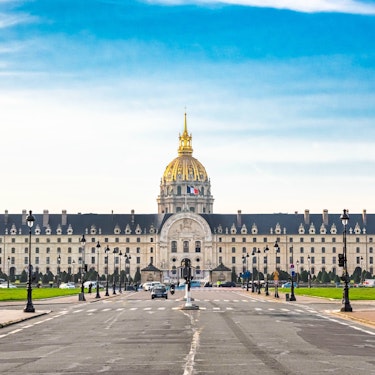More about: 3 Best Day Trips to Champagne from Paris
Located to the east of the Paris region, Champagne is one of France's historic provinces. Every year thousands of tourists visit it, attracted by the vineyards, the cellars and of course the best champagne houses.
There are endless things to see and do in Paris and yet, if you plan to stay for five days or more, a trip to the Champagne region should be on your agenda. Below are the best one-day guided tours.
1. Excursion to the Champagne region with cellar visit

These tours are popular for three reasons: they include tastings of the quintessential sparkling drink, they can be done in a day, and they offer a respite from the hustle and bustle of the capital. The bus usually leaves Paris around 7:00 am and arrives in the Champagne region in just over 2 hours.
Depending on the offers of each agency, you can stop in Épernay (where the famous Moët & Chandon is harvested), in Hautvillers (famous for having hosted the monk and cellar master Dom Pérignon) or other towns in the region.
Excursions usually include the tasting of four glasses and an expert guide who will explain both the characteristics of the wine and a little bit of local history.
By the way, if you want to repeat the gastronomic experience when you return to the capital, I recommend you read the post about the best wine and cheese tastings in Paris.
- Duration: between 10 and 12 hours
- Price: between 200 € and 250 €.
2. Day tour to the Champagne region with visit to Reims

The second route shares several of the visits of the previous option. A bus will pick you up in Paris and take you to the Champagne region. Again, the tour includes an expert guide and the tasting of three or four glasses of the famous sparkling wine.
It is worth booking this tour to learn how champagne is produced. Each bottle is made according to the Champenoise method, which involves a second fermentation of the wine in the same bottle.
You will also learn the difference between Grand Cru, Premier Cru and Cru and the other characteristics that make it possible to produce this delicacy appreciated all over the world.
After the cellars, the bus will take you to Saint-Pierre Abbey in Hautvillers (where the tomb of Dom Pérignon is located) and then to Reims, the capital of kings. 25 monarchs of the Gallic country were crowned in its splendid Gothic cathedral, which has been declared a Unesco World Heritage Site.
You will have time to stroll around the splendidly preserved old town, dotted with gems such as the Episcopal Palace, the Basilica of Saint-Remi or the splendid Art Nouveau residence Villa Demoiselle.
By the way, if you have a weakness for Art Nouveau, I recommend a visit to the Musée d'Orsay (a collection of Art Nouveau furniture, Rue de la Légion d'Honneur 1) or the Musée Maxim's (Rue Royale 3) when you return to Paris.
- Duration: about 11 hours
- Price: about 200 €.
3. Tour of the Champagne region in a vintage car

Do you have a passion for cars of yesteryear? If so, I recommend you book a tour in a Citroën 2 CV. This car is a little gem from the French manufacturer: despite its age, it is surprisingly spacious and comfortable.
This is no coincidence. Before being launched, the drivers put the car through a tough test: the 2CV had to be able to cross a ploughed field carrying two people, a basket of eggs, fifty kilos of potatoes or a barrel of wine without breaking an egg. All you have to do is sit in the back seat and enjoy the view.
The tour includes a stop at a local winery with Champagne tasting included. Unlike the previous ones, the tour does not start in Paris but in Reims. Therefore, you will have to get there on your own. For more information, I recommend you to read the post about the best excursions you can do from Paris.
- Duration: about 3 hours
- Price: about 200 €.
When is the best time to visit the Champagne region?

It would be easy to answer "spring or summer" but the real experts have no doubts: autumn is the best time. If you are travelling to Paris in September, I recommend booking a trip to the Champagne region. The grape harvest starts at the end of this month and ends in the first half of October.
What are the must-see villages in the Champagne region?

The Champagne region lies east of Paris and is made up of the departments of Aube, Marne, Haute-Marne and Ardennes. There are dozens of charming towns and the list below brings together my top 5:
- Reims, the capital of Champagne. Its most important monument is the Notre-Dame Cathedral, a Gothic temple with its characteristic central rose window and breathtaking stained glass windows. The old town is beautifully preserved and is dotted with numerous terrace bars. I recommend trying the signature pink macarons. Locals claim the best are at Douceurs Macarons (40 Rue Chanzy)
- Sedan, a medieval village on the Meuse River. You can hire a pedalo or canoe and enjoy the scenic waters. The main attraction is its castle-fortress which is the largest in Europe. You can visit it every day except 1 January and 25 December. A standard ticket costs around 9,5 €. For more info, I recommend you to consult the official website
- Chaumont, the former residence of the Counts of Champagne. Its old town houses the church of Saint-Jean-Baptiste and some elegant Renaissance houses. In December, the Musée de la Crèche (Nativity Museum) exhibits Neapolitan nativity scenes from the 18th century. By the way, if you are travelling in the last month of the year, I recommend you to read the post about the 10 things to do in Paris at Christmas
- Langres, a walled village with a history dating back to Roman times. Surrounded by forests and lakes, it is the ideal destination for hiking or mountain biking
- Epernay, a peaceful town about 30 kilometres from Reims. Its leisure and cultural offer is linked to the famous sparkling wine: under its streets are hidden several cellars where bottles of Dom Pérignon, Moët & Chandon and other brands are kept.
What are the advantages of taking a guided tour vs. visiting the Champagne region on my own?

As you have seen in the previous point, the area where the famous sparkling wine is produced can be easily reached from the capital. However, if you travel by train you can only see one location and if you rent a car you will have to drive in Parisian traffic and pay for both motorway and petrol.
A guided tour is a recommended option: the total cost includes both travel and entrance to the cellars with Champagne tastings (usually three or four glasses). You will have the opportunity to visit more than one village and estate for a price of around €200.
Although this may seem expensive, if you were to pay separately, the price would be higher. The only thing left out is food, but there is no shortage of restaurants in the area. For these reasons, a day tour in this region is definitely one of the top 10 tours and excursions from Paris.
What should I bring on an excursion to the Champagne region from Paris?

First of all, you should be aware that these tours run in the middle of the countryside and include entry to the estates where the grapes are harvested. Wear comfortable shoes because you'll be walking along cobbled paths and through cellars.
Another must in your suitcase is an umbrella or a mackintosh, as it rains frequently.
Is an excursion to the Champagne region suitable for children?

Most (if not all)guided tours allow visits with children. If they are very young, you should indicate in advance if you need a child seat. In case you are not convinced, I recommend you read the post on what to see and do in Paris with children. You will find other alternatives in and around the capital.
Is it worth taking a trip to the Champagne region in winter?

It's not the best season but that doesn't mean it's not worth it. At this time of year, temperatures often drop below freezing and it is not uncommon to see the countryside shrouded in mist or frost. The landscapes take on a magical feel, especially with a glass of Champagne in your hands.
You will need to wear warm and comfortable clothes but don't worry, if you are not convinced you can stay in the capital and fight the cold with an indoor activity. Personally, I always recommend a visit to the Invalides Museum and Napoleon's tomb or a cruise on the Seine River.













